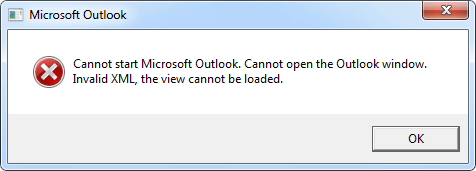Outlook 365 Won't Open
Are you having trouble starting Outlook 2016, Outlook 2013, or Outlook 2010, or receiving 'Cannot start Microsoft Outlook. Cannot open the Outlook window' error messages? We can fix the problem for you, or you can use the troubleshooting steps we're providing below to help resolve these startup issues.
Are you an Office 365 for business customer? Let us fix the problem for you
Let us fix your issue Download Support and Recovery Assistant for Office 365 |
Start Outlook in safe mode and disable add-ins
- Choose Start > Run.
- Type Outlook /safe, and choose OK.
- In the Choose Profiles dialog box, accept the default setting of Outlook and choose OK.
- If prompted, enter your password and choose Accept.
- How do you know you're working in safe mode? You'll see a label similar to the one below at the top of the screen.
- The Outlook icon on your taskbar also alerts you the program isn't operating normally.
- In the upper-left corner of Outlook, choose File > Options > Add-ins.
- At the bottom of the View and manage Office Add-ins, make sure the Manage box shows COM Add-ins, and then choose Go.
- As a precaution, when the COM Add-ins listing of your current add-ins opens, do one of the following:
- Manually record the title of every selected add-in listed under Available Add-ins.or
- Take a screenshot of the property sheet and save the image to a location of your choice.
- After you've captured the titles of the selected add-ins, clear all selected check boxes, and then choose OK.Caution: Click a check box to clear it. Don't select an add-in and choose Remove. If you have administrator rights, you could actually delete the add-in. For this troubleshooting exercise, you want to disable, not delete, an add-in.
- Choose File > Exit.
- Choose Start > Run, and in the Open box, type Outlook.Note: If the program loads properly, it's likely that one of your add-ins is the source of the error and you need to identify which one. To determine which add-in is the problem, enable one add-in at a time.
- In the upper-left corner of Outlook, choose File > Options > Add-ins.
- Select the check box next to an add-in you want to re-enable, and then choose OK.
- Repeat all steps until you've re-enabled all of the original add-ins and revealed the source of the error.Important: Remember, if Outlook opens in safe mode, you've revealed the add-in you just enabled as a source of the error.
- Restart Outlook again and disable the add-in you enabled that produced the problem, and then start Outlook.
- Make sure you go through the restart-disable-restart process for every add-in that was originally enabled in Outlook. An error could be caused by more than one add-in.
Create a new Outlook profile

- To open the Control Panel, do one of the following:
- For Windows Vista or Windows 7, choose Start > Control Panel.
- For Windows 8 and Windows 10, choose Start, and then type Control Panel.Note: For Windows 10, in Control Panel, make sure the View by box in the upper-right corner is set to Category.
- Choose Mail.
- In the Mail Setup - Outlook dialog box, choose Show Profiles > Add.
- In the Profile Name box, type the name you want to use for your new profile.
- On the Auto Account Setup page for the Add Account Wizard, under E-mail Account, fill in Your Name, E-mail Address, and Password, and then choose Next.Note: The Add Account Wizard automatically searches for your mail server settings.
- Choose Finish and you'll find the new profile name you added listed on the General tab in the Mail dialog box.
- Under When starting Microsoft Outlook, use this profile, choose Prompt for a profile to be used, and then choose OK.
- Restart Outlook
- In the drop-down list in the Choose Profile dialog box, choose the new profile name you created.
- Choose OK.Note: If Outlook starts normally, then you've identified your Outlook profile as being corrupt and the source of your problem.
Repair your Outlook data files
- Exit Outlook to use the Inbox Repair Tool.Note: The content in the left pane is determined by the Outlook version you're using.
- Visit the links below for instructions based on your version of Outlook.
Run the /resetnavpane command
- Close Outlook.
- Choose Start > Run.
- In the Open box, type Outlook.exe /resetnavpane, and then choose OK.
Check if Outlook is running in compatibility mode
Office 365 Wont Open Windows 10
- Find the Outlook.exe file on your computer.
- For Outlook 2013, you can find this file in C:Program FilesMicrosoft OfficeOffice 15 or C:Program Files (x86)Microsoft OfficeOffice 15
- Happy birthday hardik song download. For Outlook 2010, you can find this file in C:Program FilesMicrosoft OfficeOffice 14 or C:Program Files (x86)Microsoft OfficeOffice 14
- Right-click the Outlook.exe file, choose Properties, and then choose the Compatibility tab.
- If any of the boxes on the Compatibility tab are checked, uncheck them, then choose Apply > OK.
- Restart Outlook.
- As soon as Microsoft Office 365 stops working or won’t open on your system, you can directly try an online repair tool to get the problem fixed in Windows 10:
- Go to control panel on your system and select programs and then Programs and Features.
- Find and right-click on office 365 and then choose change.
- Tap on the online repair and click on the repair button.
- Simply wait for the process to complete, restart windows and see if office 365 works appropriately. If not, then try our second method.
- Search for run dialogue in the search bar and launch it or simply press Win + R.
- Type outlook /safe command, and click OK in the Run box to open outlook in safe mode.
- To open word, you can type in word /safe, and click OK.
Did you get an Outlook not responding error? Is Outlook stuck on a screen that simply says 'Processing'? Or does Outlook hang, freeze, or stop working when you're opening a file or sending an email message?
There are a number of possible reasons for Outlook to behave this way. We've presented the potential solutions in order from quickest to most time consuming.
Start Outlook in safe mode to fix 'Processing' screen
If Outlook stops responding at a screen that says 'Processing,' you can close Outlook, start it in safe mode, then close it and open it normally to fix the problem.
- Close Outlook.
- Launch Outlook in safe mode by choosing one of the following options.
- In Windows 10, choose Start, type Outlook.exe /safe, and press Enter.
- In Windows 7, choose Start, and in the Search programs and files box, type Outlook /safe, and then press Enter.
- In Windows 8, on the Apps menu, choose Run, type Outlook /safe, and then choose OK.
- Close Outlook, and then open it normally.
If Outlook isn't stuck at a screen that says 'Processing,' or this didn't resolve your issue, continue to the steps below. If those steps don't work, see Need additional help? at the end of this article.
Step 1: Is there a dialog box open?
Some things you do in Outlook ask for confirmation. For example, the first time you try to Dismiss All on a list of reminders, Outlook asks you if you're sure you want to do that. If you don't choose an option on that dialog box, Outlook won't let you do anything else. Check for open dialog boxes. Pressing Alt+Tab will help you switch from window to window and help you see what dialog boxes might be stopping Outlook from responding.
If you can't find a dialog box open, move on to the next step.
Step 2: Make sure Outlook isn't working on a large or long process
If you try to delete or move a large number of messages at once, Outlook can appear to hang, but really, it's working behind the scenes. Check the status bar at the bottom of the screen. If Outlook is performing some operation on hundreds or thousands of messages at once, it might appear to be stuck. Give Outlook a few minutes to finish the process and it should start to work again.
If Outlook isn't working on a large or long process, move on to the next step.


